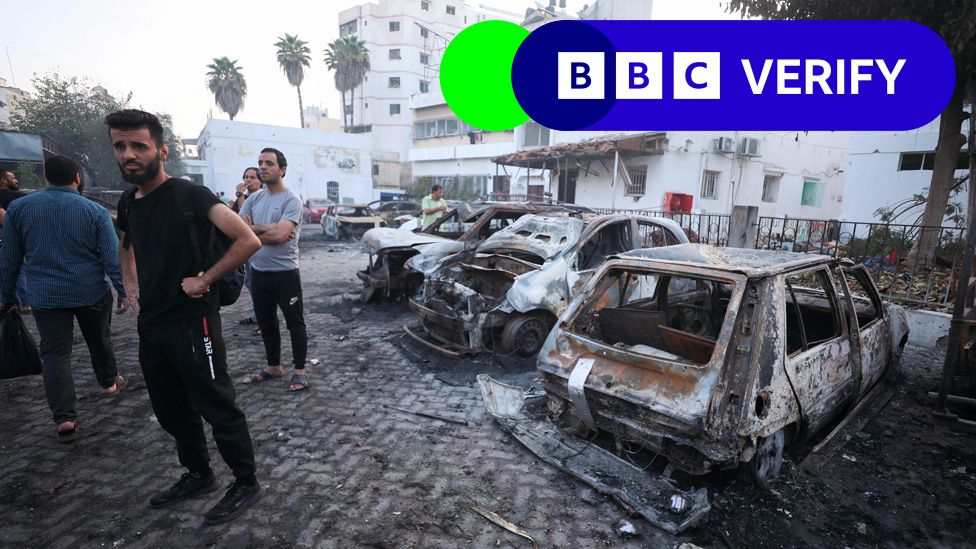A deadly blast at the crowded Al Ahli hospital in Gaza City is feared to have killed hundreds of people.
The Hamas-controlled Palestinian authorities in Gaza immediately blamed Israel, claiming it was a deliberate air strike. Israel has denied involvement.
Amid the claim and counter-claim, getting to the truth is harder than ever.
BBC Verify is trying to unravel what is and isn’t known – looking at video footage, still imagery and other evidence, including eyewitness accounts. In addition, a BBC journalist has been to the blast site, where there is limited access.
New information is emerging all the time, so we will continue to update this article as we learn more and talk to experts about the evidence.
It is also important to note that as well as the physical fighting, this conflict is playing out as an information war. This is not the first time authorities in Israel and Gaza have given completely different accounts of an explosion. We are also looking at their various claims and statements.
The blast
The explosion at the hospital happened at around 19:00 local time on Tuesday. A 20-second video which circulated on social media purporting to show the strike was the first significant piece of visual evidence to emerge of the incident.
In it, you can hear the whistling sound of an incoming projectile, followed by an explosion and a huge fire.
Live footage from the Al-Jazeera media network aired at 18:59 local time showed a bright light rising in the skies above Gaza. Some commentators have suggested it is from a rocket which appears to explode or disintegrate. It is possibly from a rocket, which appears to explode or disintegrate. From the footage, a flash is seen far away, followed by a much larger explosion closer to the camera that we’ve geolocated.
Other footage which surfaced on social media channels showed what appears to be the same blast from different angles and distances.
This video can not be played
To play this video you need to enable JavaScript in your browser.
We consulted experts to establish whether the available evidence – including the size of the explosion and the sounds heard beforehand – could be used to determine its cause.
So far the findings are inconclusive. BBC Verify has shown the evidence to a number of weapons experts, some of whom say it is not consistent with what you would expect from a typical Israeli airstrike.
J Andres Gannon, an assistant professor at Vanderbilt University, in the US, says the explosion appears to be small, meaning that the heat generated from the impact may have been caused by leftover rocket fuel rather than an explosion from a warhead.
Justin Bronk, a senior research fellow at the Royal United Services Institute (Rusi) in the UK, agrees. While it is difficult to be sure at such an early stage, he says, the evidence looks like the explosion was caused by a failed rocket section hitting the car park and causing a fuel and propellant fire.
Mr Gannon says it is not possible to determine from the footage whether the projectile struck its intended target.
Several experts we spoke to were not willing to put forward a view on what happened.
Visual evidence from the blast site
The BBC was able to match details of buildings and the layout of the Al Ahli hospital site with publicly available satellite imagery, to establish the hospital was the scene of the blast.
Based on available evidence, it appears the explosion happened in a courtyard which is part of the hospital site. Images of the ground after the blast do not show significant damage to surrounding hospital buildings. What the images do show includes scorch marks and burnt-out cars.

The hospital is owned and run by the Anglican Church.
Canon Richard Sewell, the dean of St George’s College in Jerusalem, told the BBC that about 1,000 displaced people were sheltering in the courtyard when it was hit, and about 600 patients and staff were inside the building.

What BBC reporter found
BBC reporter Rushdi Abualouf has been to the the Al Ahli Hospital this morning. Witnesses there report scenes of devastation, and say bodies are still being collected.
One man told him that women, children and elderly people were at the hospital when the explosion happened.
We are still analysing images and footage of the victims to determine what they can tell us about the blast from the nature of their injuries.
This video can not be played
To play this video you need to enable JavaScript in your browser.
What we don’t know yet
One of the most critical pieces of evidence is the nature of the crater left behind by the explosion.
The Israel Defence Forces (IDF) say that the absence of a large crater, or blast damage to adjacent buildings, proves that the explosion was not caused by its weapons.
You can see one small crater and we’re seeing if any of the other marks represent other craters.

Another important part of missing evidence is missile fragments. Projectiles are often identifiable by the wreckage of their shell, and they can be used to determined the projectile’s origin. But in this case, we have not seen that evidence.
Additional reporting by: Daniele Palumbo, Joshua Cheetham, Tom Spencer and Shayan Sardarizadeh


More on Israel-Gaza war
- Follow live: Latest updates
- Explained: What’s going on in Gaza and Israel, and why now?
- History behind the story: The Israel-Palestinian conflict
- Hamas attack: Family seeks answers after live-stream horror
- From Gaza: BBC reporter flees Israel bomb warning

